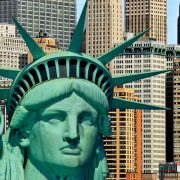The COVID-19 pandemic has caused an unprecedented health crisis, and the resulting lockdowns have caused an unprecedented economic crisis. To help U.S. workers get back up on their feet as the United States slowly reopens its economy, President Trump signed into law on April 22, 2020, a temporary immigration ban. The ban halted certain forms of immigration for 60 days, but now, the ban’s period has come to an end, yet the economic fallout persists. Therefore, on June 22, 2020, Trump signed a new order expanding and extending the ban until the end of 2020. The intention of the proclamation is to prioritize U.S. citizens and residents for jobs as they become available, ideally sinking the unemployment rate to pre-pandemic levels. The ban does, of course, allow some exceptions, such as, notably, investors in the EB-5 Immigrant Investor Program.
The newly extended immigration ban went into effect June 24, and now, until the end of 2020, any non-exempt immigrants who don’t have a valid visa or travel document other than a visa will be unable to enter the United States for employment purposes. Foreign nationals coming from certain countries may be granted entry as visitors, but they cannot engage in work activities in that case. According to the proclamation, U.S. officials expect the U.S. economic recovery efforts to last several months, which is how they justify the extended immigration ban. Going forward, U.S. citizens and residents will not have to compete with foreign nationals holding work visas for jobs. The new ban also adds the H-1B, H-2B, L, and J nonimmigrant work visas. Any foreign nationals currently residing in the United States under these or other work visas, however, are not affected by the proclamation.
Who’s Exempt From the Immigration Ban?
Some immigrants will still be permitted to enter the United States. One group that will always be able to enter, for example, are those who already have a U.S. green card. Similarly, the spouses and unmarried children younger than 21 of U.S. citizens or residents may enter the country despite the ban. The proclamation has also granted special status to doctors, nurses, and other medical professionals to assist in the fight against the COVID-19 virus. Another group exempt from the immigration ban are EB-5 investors, who made the cut despite four U.S. senators penning an open letter to President Trump on May 7 and asking Trump to expand the immigration ban to EB-5 investors, among others.
However, just because EB-5 investors may still immigrate to the United States as per the immigration ban doesn’t mean they don’t face difficulties in 2020. Around the world, countries have imposed strict travel restrictions, which may prevent EB-5 investors from traveling to the United States. Notably, the United States has banned travel from certain countries and closed its land borders with Canada and Mexico. Additionally, to be eligible for entry into the United States, an EB-5 investor must have obtained their EB-5 visa, which has been rendered impossible for some. All U.S. embassies and consulates have temporarily stopped offering routine visa services, which has left many overseas EB-5 investors unable to obtain their visas. The restrictions thus form a de facto immigration ban for many EB-5 investors, although the situation is likely to change before the end of 2020.
The EB-5 Program: The Best Way to Immigrate to the United States
The EB-5 program is clearly better than other immigration programs during the COVID-19 pandemic, but it also reigns supreme during normal times. The H-1B and L visas are popular, but the fact remains that they only permit a temporary stay in the United States—they’re not appropriate for those who wish to immigrate to the United States long term. It’s not easy for foreign nationals to find an employer willing to sponsor them for such visas, and in the case of the H-1B, applicants still have to compete in a lottery system due to the overwhelming demand for the program. Those who do come to the United States on H-1B visas then face stringent restrictions regarding employment and are forbidden from engaging in work activities outside of their employer.
EB-5 visa holders don’t have to face any of these obstacles. EB-5 visa holders can live, work, study, and travel anywhere in the vast country of the United States—true American freedoms. Their status as U.S. permanent residents grants them the right to live in the United States permanently, and it even allows them to apply for U.S. citizenship after a certain number of years. The spouses and unmarried children younger than 21 of EB-5 investors likewise receive U.S. green cards.
It is fairly simple to participate in the EB-5 program—the most important requirement is the appropriate amount of investment funds. Investors need $900,000 for projects in targeted employment areas (TEAs) and $1.8 million for non-TEA projects. All their funds must also have been legally sourced—proving the lawful source of investment funds is a further EB-5 requirement. Investors file an I-526 petition to launch the EB-5 process and then apply for two-year conditional permanent resident status. During the two-year period, they must keep their EB-5 investment at risk, and at the end of the period, they must file an I-829 petition where they demonstrate that their investment has resulted in at least 10 new full-time jobs to be occupied by U.S. citizens and residents. Upon the approval of their I-829 petition, they receive unconditional permanent resident status, and their EB-5 journey is complete.







